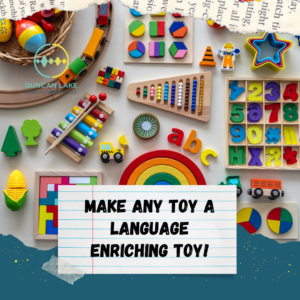by Tamiko Teshima, M.A., CCC-SLP
Practice Owner & Speech-Language Pathologist
Duncan Lake Speech Therapy, LLC
This time of year, our team is often asked for input on gift giving. Most questions are typically about what toys are best for language development. The truth is that there is absolutely no toy on the planet that will help your child’s language development on its own. However, with the use of parent strategies, any toy can be a language development tool!
I wrote this original post back in 2020, and I thought I’d take some time to give it a bit of a refresh. By using the strategies below, you can make any toy a language enriching toy!
Enhancing your child’s language development doesn’t hinge on purchasing specific toys; it’s about how you engage with them during play. Here are some strategies to transform any toy into a language-enriching tool.

- Participate Actively: Join your child in their playtime. Your involvement provides rich language models and fosters communication. For instance, if they’re playing with blocks, build alongside them and describe your actions.
- Model Language: Narrate your activities and describe objects during play. If your child points to a toy car, you might say, “That’s a red car. The car goes fast!” This exposes them to new vocabulary and sentence structures.
- Expand on Their Speech: When your child uses a word or phrase, respond by adding more detail. If they say, “Dog,” you could reply, “Yes, the big brown dog is barking.” This encourages them to form longer sentences.
- Balance Comments and Questions: Aim for a ratio of three comments to every question. Instead of asking, “What color is this?” you might comment, “This blue ball bounces high.” This approach reduces pressure and promotes natural conversation.
- Engage in ‘Serve and Return’ Interactions: Respond to your child’s communication attempts—be it words, gestures, or sounds. If they reach for a puzzle piece, you might say, “You want the blue piece? Here it is!” This reinforces the back-and-forth nature of communication.
- Introduce Playful Challenges: Intentionally make playful mistakes, like placing a doll’s hat on its foot. This encourages your child to correct you, prompting them to use language to explain the error.
- Limit Battery-Operated Toys: Toys with lights and sounds can be overstimulating and may limit opportunities for your child to use their own language skills. Opt for simple toys that encourage imagination and verbal interaction. OR if you have battery-operated toys, take the batteries out every once in a while.
- Rotate Toys: Instead of overwhelming your child with too many options, offer a select few toys at a time. This can enhance focus and imaginative play, providing richer opportunities for language use. If you’re looking for tips for how to set this up, check out this blog post.
Remember, the key to language enrichment is your interactive engagement during play. Your presence and communication transform any toy into a powerful tool for language development. This holiday season, focus more on the time you spend playing with your child rather than the toys themselves. You are your child’s most powerful language-learning tool!



Recent Comments